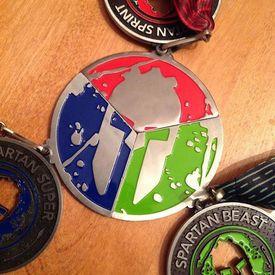Runners - Miles on sneakers

laurie62ann
Posts: 433 Member
I have read that you should retire your sneakers and get new ones every 500 miles. Is this true for runners or should I retire them sooner. I've got just over 400 and I've noticed that I'm getting shin-splints. I'm wondering if I need new sneakers.
Thoughts!
Thoughts!
0
Replies
-
I get new trainers whenever I feel my old ones aren't supporting my feet and ankles as they should.
Its all about the support for me, not the milage BUT spending the money on a good pair of trainers will get you the support for long and therefore a greater milage. Some things, like trainers, are definitely worth the investment.0 -
If you are getting shin splints and you haven't changed up your running routine then yes it is time for new kicks.
The distance of shoe actually varies.
>Brand
>Surface
>Type of Treads
>Footfall of the runner
>Weight of the runner
>Weather conditions used
Plus many other factors can determine the life of a shoe. So for someone who needs a new shoe at 500 miles, another person may have to get nwe ones at 300. It all depends on the different aspects of the person using them.0 -
I've recently heard the same thing when I posted about back pain. I have about 800 miles on my shoes now and I think it is just about time to get new ones. But many of the responses I got stated 500 miles = new shoes. I suppose your stride, trail vs treadmill running all makes a difference.0
-
I just kind of play it by ear. I once had a pair go over 1000 miles and I would not recommend that, but once they start feeling uncomfortable, like you said you are getting shin splints, it may be time for a change. I usually go over 500 miles on my shoes though, don't want to throw away my money every 2 months.0
-
400 miles is a good number to retire them! I have one pair that has over 700 miles that I just can't get rid of but I swap them out with two other pairs regularly. I think if your feet and shins are hurting it would be the first place to start.0
-
I replace mine when ether my toes are sticking out or there is no rubber left on the bottom. My last pair got 2800 miles before I retired them.0
-
It depends. Different shoes wear out at different rates for different people. For example, someone 300lbs is going to break down the support in a shoe a lot faster than someone 150lbs.
I just go by feel. One pair I got 2 full seasons out of (no idea the actual mileage), the next pair I only got 1 season from (similar amounts of running each season, so roughly half the miles).0 -
 http://www.youtube.com/watch?v=ylgzgbzC9i4&list=FLqYl5lJFLyD4VLihoUo_h9A&index=3
http://www.youtube.com/watch?v=ylgzgbzC9i4&list=FLqYl5lJFLyD4VLihoUo_h9A&index=3
^^ video by a podiatrist, on how to tell when you need to replace your shoes.
But, basically what the others have said above. It will vary on a lot of factors. So sometimes you'll get a lot more than 500 miles, sometimes a lot less.0 -
I don't really know how many miles I have on my 2 pairs of shoes right now. I can generally tell when I need new shoes. I start getting shin splints and calf pain. I do a quick reality check trying to figure out if I've been doing anything different with my training if not, I figure out what shoes have more miles and replace them. So far it has fixed my problems every time.0
-
I find mine need retiring somewhere between 400 & 500 miles. The breakdown is slow so It's hardly noticeable but it really jumps out at me the moment when I make the first run in a new pair.
For what its' worth, I'd strongly recommend that if you're going to race do NOT do it in brand new shoes! Get the new ones at least a month before the race & wear them regularly to get they & your feet used to each other.0 -
Should have added, all my miles are outside irregardless of weather conditions on paved asphalt roads. I'm 207 to 215 ish. This may cause mine to break down quicker than what a lighter runner using a treadmill would experience.0
-
yeah, now that i can understand!I replace mine when ether my toes are sticking out or there is no rubber left on the bottom. My last pair got 2800 miles before I retired them.
other than that, just get a pair of new foam insoles = $20 -
yeah, now that i can understand!I replace mine when ether my toes are sticking out or there is no rubber left on the bottom. My last pair got 2800 miles before I retired them.
other than that, just get a pair of new foam insoles = $2
Except that does nothing to help with support, for those who need it.0 -
I find I can extend the life of my shoes by about 100% if I swap to an aftermarket insole when I start to feel the shoe is giving me less support. I don't buy the real expensive insoles, but he ~$20 ones that are heavy foam sometimes with a little plastic cup in the arch. One store I buy them from has a 1 year guarantee on the insoles so when they start to break down I take them back and get a brand new pair.
So the cycle usually looks like this...
New shoes running in the original insoles
3 months in i'm starting to lose support and I get a pair of after market insoles
Another 3 months and the shoes are pretty trashed and relegated to lawn mowing and gardening work.
I buy new shoes with the original insoles.
3 months later I take my old after market insoles back and get a free pair and put them in my shoes because I'm starting to lose support.
And the cycle goes on and on every 6 months getting new shoes.0 -
I should have added that my feew don't need any support. I only need enough shoe to protect the bottom of my feet from rocks and other stuff on the pavement.
yeah, now that i can understand!I replace mine when ether my toes are sticking out or there is no rubber left on the bottom. My last pair got 2800 miles before I retired them.
other than that, just get a pair of new foam insoles = $2
Except that does nothing to help with support, for those who need it.
For anyone who replaces shoes to get more cushion, most of the cushioning in the shoe is gone far before you reach even 100 miles. That doesn't really matter though because that doesn't change the impact forces in your legs one bit. The body is smart and automatically adjusts for running surface, including the cushion under your feet. Impact forces to your body are the same whether you run with marshmellow shoes or completely barefoot.0 -
Many factors determine when you need to get new running shoes but the top is look at the tread....is there any left? Are you still getting the support you require when running?
I try to keep two pairs of shoes and alternate because this helps them last longer, and also helps me with my stride, and prevent injury.
And since I run mostly on the road; I end up replacing my shoes at around 350 - 400 miles.0 -
I get new trainers whenever I feel my old ones aren't supporting my feet and ankles as they should.
Its all about the support for me, not the milage BUT spending the money on a good pair of trainers will get you the support for long and therefore a greater milage. Some things, like trainers, are definitely worth the investment.
This or in other words, when they hurt you feet, legs, knees, whatever.0 -
Check the sides of the soles for wrinkles. If they're there, then the sole has compressed and is no longer doing its job.0
-
For anyone who replaces shoes to get more cushion, most of the cushioning in the shoe is gone far before you reach even 100 miles. That doesn't really matter though because that doesn't change the impact forces in your legs one bit. The body is smart and automatically adjusts for running surface, including the cushion under your feet. Impact forces to your body are the same whether you run with marshmellow shoes or completely barefoot.
I have a good friend who runs ultra marathons and he says the same thing.
He also suggested to me to hold on to some of the shoes that I was about to throw out and rotate them in with newer shoes. He strongly believes that running with different types of cushioning helps the feet/legs/body adapt better to the stresses of running. So, I have about 5 pairs of shoes in my rotation and I have been running injury free since I started this practice.0 -
I should have added that my feew don't need any support. I only need enough shoe to protect the bottom of my feet from rocks and other stuff on the pavement.
yeah, now that i can understand!I replace mine when ether my toes are sticking out or there is no rubber left on the bottom. My last pair got 2800 miles before I retired them.
other than that, just get a pair of new foam insoles = $2
Except that does nothing to help with support, for those who need it.
For anyone who replaces shoes to get more cushion, most of the cushioning in the shoe is gone far before you reach even 100 miles. That doesn't really matter though because that doesn't change the impact forces in your legs one bit. The body is smart and automatically adjusts for running surface, including the cushion under your feet. Impact forces to your body are the same whether you run with marshmellow shoes or completely barefoot.
Is cushion different than support? To me, people want cushion to aleviate imapct, support to control/correct pronation issues.0 -
By cushion I mean the ability of the sole to compress beneath the feet with each step. Studies have shown that it doesn't really alleviate impact because the body adjusts to keep the impact fairly constant. If you put a big cushion under the feet the leg just steps down harder to find the ground. With less, or compressed, cushion the leg just steps lighter. Either way the impact is about the same. It does however protect the feet from stuff like rocks on the ground. In my opinion, as long as there is enough sole left to protect the feet from the hazards of the running surface there is no good reason to replace the shoe.
I should have added that my feew don't need any support. I only need enough shoe to protect the bottom of my feet from rocks and other stuff on the pavement.
yeah, now that i can understand!I replace mine when ether my toes are sticking out or there is no rubber left on the bottom. My last pair got 2800 miles before I retired them.
other than that, just get a pair of new foam insoles = $2
Except that does nothing to help with support, for those who need it.
For anyone who replaces shoes to get more cushion, most of the cushioning in the shoe is gone far before you reach even 100 miles. That doesn't really matter though because that doesn't change the impact forces in your legs one bit. The body is smart and automatically adjusts for running surface, including the cushion under your feet. Impact forces to your body are the same whether you run with marshmellow shoes or completely barefoot.
Is cushion different than support? To me, people want cushion to aleviate imapct, support to control/correct pronation issues.
Support is the other stuff they build into shoes to correct pronation. Since I don't use those types of shoes I really don't know how long those support structures last.0 -
I've heard 500 miles since I was in High School and not much has changed. Though because of my weight, I tend to replace mine every 300 miles0
-
By cushion I mean the ability of the sole to compress beneath the feet with each step. Studies have shown that it doesn't really alleviate impact because the body adjusts to keep the impact fairly constant. If you put a big cushion under the feet the leg just steps down harder to find the ground. With less, or compressed, cushion the leg just steps lighter. Either way the impact is about the same. It does however protect the feet from stuff like rocks on the ground. In my opinion, as long as there is enough sole left to protect the feet from the hazards of the running surface there is no good reason to replace the shoe.
I should have added that my feew don't need any support. I only need enough shoe to protect the bottom of my feet from rocks and other stuff on the pavement.
yeah, now that i can understand!I replace mine when ether my toes are sticking out or there is no rubber left on the bottom. My last pair got 2800 miles before I retired them.
other than that, just get a pair of new foam insoles = $2
Except that does nothing to help with support, for those who need it.
For anyone who replaces shoes to get more cushion, most of the cushioning in the shoe is gone far before you reach even 100 miles. That doesn't really matter though because that doesn't change the impact forces in your legs one bit. The body is smart and automatically adjusts for running surface, including the cushion under your feet. Impact forces to your body are the same whether you run with marshmellow shoes or completely barefoot.
Is cushion different than support? To me, people want cushion to aleviate imapct, support to control/correct pronation issues.
Support is the other stuff they build into shoes to correct pronation. Since I don't use those types of shoes I really don't know how long those support structures last.
ok. I agree about the cushion... I wasn't sure if support was rolled into your previous comment about being gone in the first 100 miles.0 -
I can feel it in my lower back, usually happens around 700+ miles
Often shin splints are from overuse. Have you recently increased your training volume?0 -
yes, get some new shoes0
-
Bump :happy:0
-
Totally depends on the shoe. I wear "performance" shoes - they're lighter for racing (despite me being slow, hey, I wear them because they're prettier LOL). Because of that, they wear out sooner. I replace them at about 350 miles.
I just wore my newly retired ones on the 3Day 60 mile walk for breast cancer. That probably put them at around 420 miles. They are TOAST. I wore them to workout with my trainer Saturday (not cardio) and was sliding all over the place LOL. A shame really, given they look brand new from the top view!0 -
im not sure about "the body adjusting" for cushioning or a hard running surface. Why are we always told not to run on the pavement, it causes shin splints? or why do they make a shock absorbing treadmill?0
-
I can feel it in my lower back, usually happens around 700+ miles
Often shin splints are from overuse. Have you recently increased your training volume?
"Yes", I didn't think much about it but I went from 3 miles to 4/5 miles. Then after reading everyone's post I also realized I'd gone form crushed stone to pavement/sidewalks. So I'm cutting back for a while to see if the shin splints go away.0 -
Thanks for everybody's input!0
This discussion has been closed.
Categories
- All Categories
- 1.4M Health, Wellness and Goals
- 398.4K Introduce Yourself
- 44.7K Getting Started
- 261K Health and Weight Loss
- 176.4K Food and Nutrition
- 47.7K Recipes
- 233K Fitness and Exercise
- 462 Sleep, Mindfulness and Overall Wellness
- 6.5K Goal: Maintaining Weight
- 8.7K Goal: Gaining Weight and Body Building
- 153.5K Motivation and Support
- 8.4K Challenges
- 1.4K Debate Club
- 96.5K Chit-Chat
- 2.6K Fun and Games
- 4.7K MyFitnessPal Information
- 17 News and Announcements
- 21 MyFitnessPal Academy
- 1.5K Feature Suggestions and Ideas
- 3.2K MyFitnessPal Tech Support Questions


















